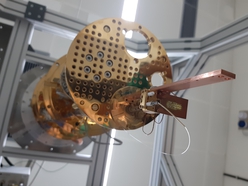Cryogenic detectors and Quantum Sensing
Low noise and excellent energy resolution for sensing single particles
Any Light Particle Search
Low noise and excellent energy resolution for sensing single particles
Cryogenic detectors have become a great asset to fundamental science including astrophysics, particle physics, and materials science: These detectors promise extremely low noise as well as an unprecedented energy resolution. To enable this, cryogenic detectors use mechanisms mostly based on superconductivity, that require sub-Kelvin temperatures.
As particle physicists, our main motivation for cryogenic detectors is their ability to measure single particles also of low energy and low rate.
We at ALPS are researching cryogenic detectors with a focus on Transition Edge Sensor (TES) Systems, which exhibit a sharp change in resistance in the vicinity of its superconducting transition temperature (below 1 K) in response to change in temperature.
One of our main applications is the ALPS II experiment, where we want to measure single infrared photons which could be produced from axions (or axion-like-particles (ALPs)). As these photons are expected to be very rare, we specialize in achieving a comprehensive understanding of background and noise, as well as minimizing their impact. For this, we are using advanced technologies and high-performance analysis methods including Machine Learning as well as simulations of the system.
Furthermore, we are looking into other applications like direct dark matter searches with our setup and measurements relevant to quantum computing as well as into other cryogenic sensors.
For our experiments, we are operating and utilizing the infrastructure of two cryostats (dilution refrigerators), capable of reaching temperatures as low as 20 mK.
In our Cryogenic Detector Working Group we from the DESY-ALPS group work together with colleagues from Hamburg University, the University of Southern Denmark and the Helmut Schmidt University. In the consortium "Quantum-Enhanced Interferometry for New Physics" we collaborate with the University of Glasgow, who is also the co-owner of one of our cryostats.
We receive support from the PTB Berlin and NIST in the U.S.A. Our TES devices come from NIST and our SQUIDs from PTB.

